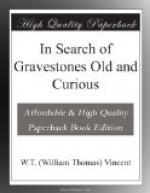Fig. 13.—At erith.
It may be noted that this also is of the seventeenth century, and the mode of describing John Green’s age is, I think, unique.
High Halstow is a neighbour of Hoo, and has only of late been penetrated by the railway to Port Victoria.
From High Halstow we have another curious and almost heathenish specimen, in which we see the crossbones as an addition to the “skull,” if “skull” it can be considered, with its eyes, eyebrows, and “cheeks.”
[Illustration: Fig. 11. Ridley.]
[Illustration: Fig. 12. Hoo.]
[Illustration: Fig. 13. Erith.]
[Illustration: Fig. 14. High Halstow.]
[Illustration: Fig. 15. Frindsbury.]
[Illustration: Fig. 16. Higham.]
Fig. 14.—At high Halstow.
“To Susan Barber.” The
date is buried, but
there is a similar
stone close by dated
1699.
Nearer Rochester, at Frindsbury, there is the next illustration, still like a mask rather than a death’s head, but making its purpose clear by the two bones, such as are nearly always employed in more recent productions.
Fig. 15.—At Frindsbury.
“To William David Jones, died 1721.”
There is, however, another at Higham of about the same date, in which, supposing a skull to be intended, the inspiration of the bones appears not to have caught the artist. The portrait theory may possibly better fit this case.
Fig. 16.—At Higham.
“To Mr Wm Boghurst, died 5th of
April 1720,
aged 65.”
That some of the carvings were meant for portraits cannot be denied, and, in order to shew them with unimpeachable accuracy, I have taken rubbings off a few and present an untouched photograph of them just as I rubbed them off the stones (Fig. 17). The whole of the originals are to be found in the neighbouring churchyards of Shorne and Chalk, two rural parishes on the Rochester Road, and exhibit with all the fidelity possible the craftsmanship of the village sculptors. They will doubtless also excite some speculation as to their meaning. My belief, as already expressed, is that the uppermost four are the embodiment of the rustic yearning for the ideal; in other words, attempts to represent the emblem of death—the skull. Nos. 1 and 2 are from Shorne; Nos. 3, 4, and 5 from the churchyard at Chalk.
In No. 1 we have, perhaps, the crudest conception extant of the skeleton head. The lower bars are probably meant for teeth; what the radial lines on the crown are supposed to be is again conjecture. Perhaps a nimbus, perhaps hair or a cap, or merely an ornamental finish. The inscription states that the stone was erected to the memory of “Thomas Vdall,” who died in 1704, aged 63 years.




